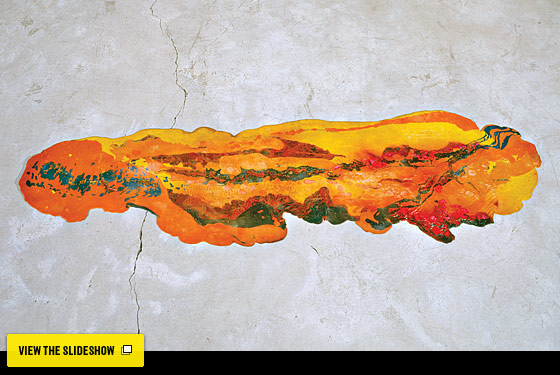
The history of modernism reads like an aesthetic Book of the Dead. At the first glimmering of photography, painter Paul Delaroche fretted, “From today, painting is dead.†In 1912, ÂDuchamp mused, “Painting is washed up.†Aleksandr Rodchenko pronounced his 1921 monochromes “the end of painting.†Critic Harold Rosenberg was fond of a line, popular among the AbEx crowd, declaring that the painting of “Newman had closed the door, Rothko had pulled down the shades, and Reinhardt had turned out the lights.†And ReinÂhardt himself once said, “I am merely making the last painting which anyone can make.â€
That was not, of course, what happened, but such exaggerations do provide a backdrop for “Unpainted Paintings,†a rousing group show of art stars, underdogs, and newcomers organized by Palazzo Grassi curator Alison Gingeras. The show’s 37 works date from 1954 to the present and track what happened after the big bang of Pollock’s drips. Essentially, artists like ÂMartin Kippenberger, Mike Kelley, Steven Parrino, and Blinky Palermo went around the dilemma of “What next?,†riffing with rubber, garbage, beads, buttons and burlap, stainless steel, even urine. Yves Klein traded his brush for a blowtorch. Robert Rauschenberg used gold leaf. Paul ÂMcCarthy poured chocolate on carpet. ÂDavid Hammons used Kool-Aid to make a candy-colored Rothko.
A lot of the work in “Unpainted†is hard to take—even ugly. Some of it looks like junk. But much of it I love because it shows how fluid and uncanny beauty and form can be. Sit with the work here and you will find you are using your imagination more than your eyes. The show starts with a knee-knocking piece, just inside the door: a seventeen-foot-long Warhol “piss painting†made by Factory assistants urinating on canvas (presumably as Andy eagerly watched: “A little to the left, Geraldâ€; “Oh, gee, Ronnie, you missed a spotâ€). In these phosphoric, alchemical works, Warhol transforms studio into lavatory, piss into ready-made paint, and painting into something that is simultaneously ironic and sincere. The painting here is as exquisite as the glaze on Ming vases, as mysterious as cave painting, as strangely powerful as Christian reliquaries containing teeth and foreskins. (The streams of color in most piss paintings look like the work of men. But the puddles and ponds of the canvas in “Unpainted†make me think it was made by women.)
One of the show’s pleasant surprises is Dan Colen’s fifteen-foot Psychotic ÂReaction, made by sprinkling flower petals on canvas. Of course it literalizes Monet, apes Warhol, and clucks about the decay implicit in ÂDamien Hirst’s butterfly paintings, yet the prettiness and impressive feel for the optical field suggests that Colen, whose last show was a bust, is capable of arresting conceptual work. I also love excellent newÂcomer Anna Betbeze’s Marble, a peltlike piece (acid-dyed and tinted with watercolor) that conjures prehistoric punk garments or a dead-Wookiee rug. It’s probably an homage to another stunner, Lynda Benglis’s tremendously influential 1969 poured-Âpigment painting, Baby Contraband, which sits on a floor here; you can almost feel the frisson as the artist breaks painting out of its historical-spatial confines.
The Warhol, like most work in this show, points to a time when artists traded sincerity and authenticity for detachment and a sometimes acute self-awareness. Instead of still lifes, landscapes, and portraits, the content became about process, composition, self-criticism, tactility, humor, and the questioning of a blind faith in art. This can get monotonous, and so does “Unpainted Paintings.†But at its best, it offers a glimpse of how wild and pliable and strange art can be. One hopes you will leave understanding what Robert Rauschenberg meant when he observed, “An empty canvas is full.â€
Unpainted Paintings
Luxembourg & Dayan.
Through May 27.

Anne Betbeze, Marble (2011) Photo: Courtesy of the artist and Kate Werble Gallery

Lynda Benglis, Baby Contraband (1969) Photo: Courtesy of the artist, Luxembourg & Dayan, New York, and Cheim & Read, New York

Dan Colen, Psychotic Reaction (2011) Photo: Courtesy of Gagosian Gallery

Yves Klein, F124 (1961) Photo: Courtesy of L&M Arts

David Hammons, Untitled (Kool-Aid) (2007) Photo: Courtesy of Salon94 and L&M Arts
